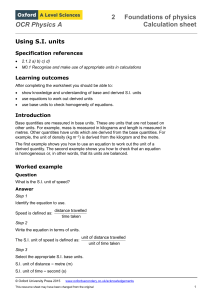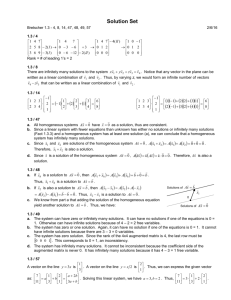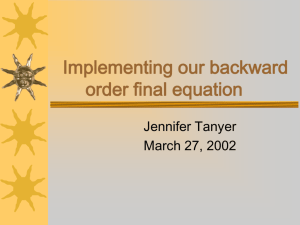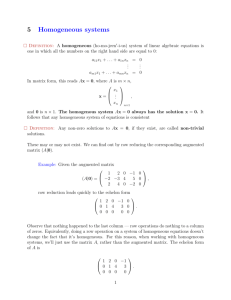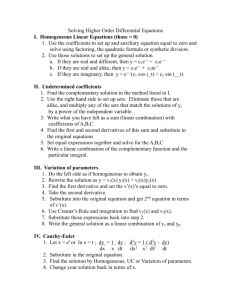OCR Physics A Using S.I. units Specification references 2.1.2 a) b) c
advertisement
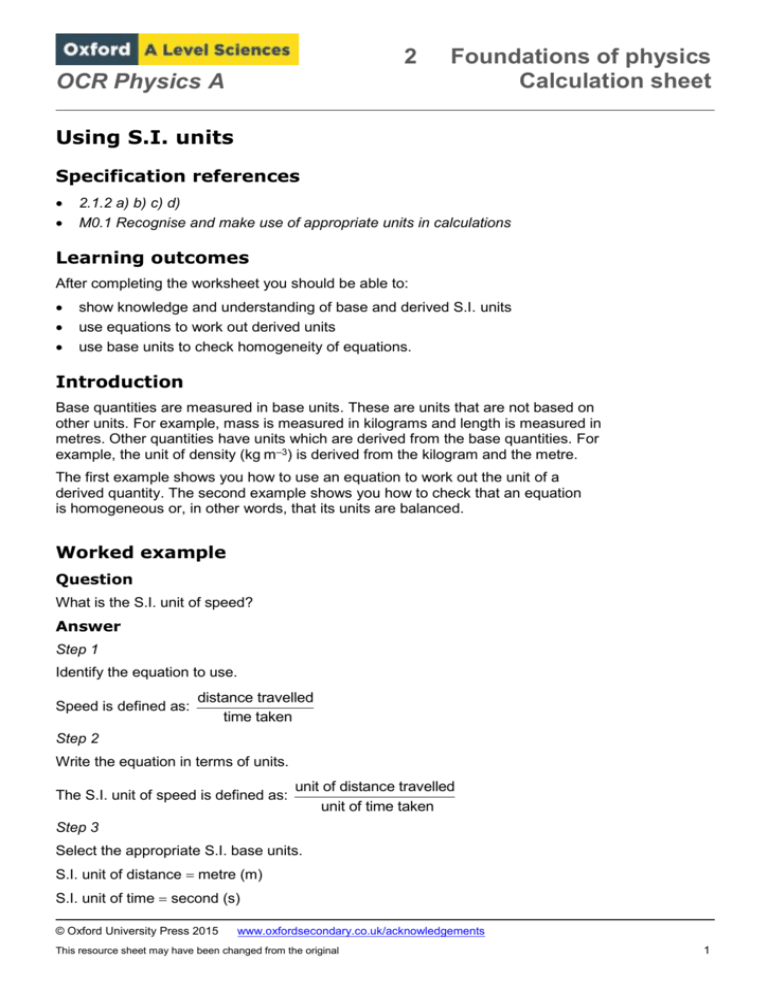
2 OCR Physics A Foundations of physics Calculation sheet Using S.I. units Specification references 2.1.2 a) b) c) d) M0.1 Recognise and make use of appropriate units in calculations Learning outcomes After completing the worksheet you should be able to: show knowledge and understanding of base and derived S.I. units use equations to work out derived units use base units to check homogeneity of equations. Introduction Base quantities are measured in base units. These are units that are not based on other units. For example, mass is measured in kilograms and length is measured in metres. Other quantities have units which are derived from the base quantities. For example, the unit of density (kg m–3) is derived from the kilogram and the metre. The first example shows you how to use an equation to work out the unit of a derived quantity. The second example shows you how to check that an equation is homogeneous or, in other words, that its units are balanced. Worked example Question What is the S.I. unit of speed? Answer Step 1 Identify the equation to use. Speed is defined as: distance travelled time taken Step 2 Write the equation in terms of units. The S.I. unit of speed is defined as: unit of distance travelled unit of time taken Step 3 Select the appropriate S.I. base units. S.I. unit of distance metre (m) S.I. unit of time second (s) © Oxford University Press 2015 www.oxfordsecondary.co.uk/acknowledgements This resource sheet may have been changed from the original 1 2 Foundations of physics Calculation sheet OCR Physics A Step 4 Insert the S.I. base units into the equation. S.I. unit of speed metre (m) metre per second m s–1 time taken (s) Question 1 Work out the missing units, unit symbols and names, equations, and quantities in this table. (1 mark for each correct answer) Physical quantity Equation used Unit Derived unit symbol and name frequency 1 time period a Hz hertz volume length3 b – acceleration velocity time c – force mass acceleration kg m s–2 d work and energy force distance e J joule voltage energy electric charge J C–1 f electrical resistance g V A–1 h momentum mass velocity i – impulse force time j – k force area l Pa pascal m n kg m–3 – Worked example Question Check that the equation: kinetic energy © Oxford University Press 2015 1 m v2 is homogeneous. 2 www.oxfordsecondary.co.uk/acknowledgements This resource sheet may have been changed from the original 2 2 OCR Physics A Foundations of physics Calculation sheet Answer Make sure you always state which side of the equation you are working on, left-hand side (LHS) or right-hand side (RHS). Step 1 Start with the LHS. The unit of kinetic energy is the joule. Change this to base units. LHS: J N m kg m s–2 m kg m2 s–2 Step 2 Repeat Step 1 for the RHS. RHS: units of 1 m v2 are kg (m s–1)2 kg m2 s–2 2 (The constant, 1 , is a number with no units.) 2 Step 3 Don’t forget to write your conclusion. LHS RHS so the equation is homogeneous. 1 in the equation, so we cannot say that the equation is 2 correct, only that it is homogeneous. We can’t tell that there is a Questions 2 3 4 Use base units to show the equation Q I t for electric charge passing a point in time t, when the electric current is I, is homogeneous. Use base units to show that the equation P I V is homogeneous, where I is electric current, V is voltage, and P is power measured in watts (W). (Hint: 1 W 1 J s–1) The Earth’s gravitational field strength, g 9.81 N kg–1, is also sometimes given as the acceleration due to gravity, g 9.81 m s–2. Show that these units are equivalent. (1 mark) (2 marks) (1 mark) Maths skills links to other areas You may also need to check equations are homogeneous wherever they are used in the specification – examples can be found in Chapter 3 Motion, and Topic 4.8 Density and pressure. You can also use this method to help you decide whether you have remembered an equation correctly. © Oxford University Press 2015 www.oxfordsecondary.co.uk/acknowledgements This resource sheet may have been changed from the original 3
